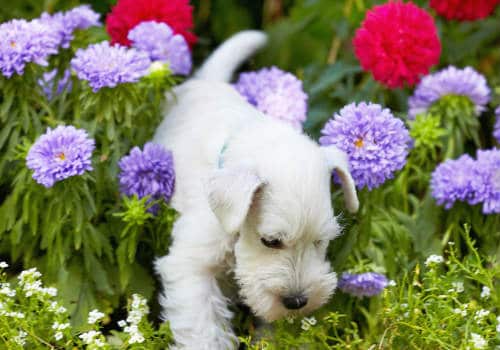Spring has sprung, and all those gorgeous flowers in your garden have begun to bloom. They delight the eyes with their bright colors and amaze the nose with their delicate scents.
At least, they do until your dog gets his paws on them.
Maybe it’s the allure of a diggable dirt patch that draws him to your flower beds. Or maybe it’s a twisted way of showing appreciation for that floral beauty.
Whatever the reason, all you know is that you want your dog as far away from your flowers as possible.
But how do you go about doing that without hindering your own appreciation of your blooming garden?
If you’re struggling to keep your dog out of your flower beds, try these simple tricks. They’re easy, inexpensive, and highly effective at preserving your beautiful garden without disappointing your dog!
Simple Tips for Keeping Dogs Out of Flower Beds

Try a Dog Repellent Spray
Before making any drastic modifications to your flower beds, try protecting them with a simple dog repellent spray. These sprays take advantage of a dog’s sensitive nose by coating your garden in oils that smell fine to us but terrible to dogs.
You can make your own dog repellent spray at home or use a store-bought product. Here are our recommendations for each option.
Make Your Own Dog Repellent Spray
Three common household items and ingredients can be used to keep dogs out of your flower garden: vinegar, citrus, and hot pepper.
The simplest is low-acidity (4-5%) white or apple cider vinegar, which can be sprayed directly onto the soil. Vinegar’s scent is repulsive to dogs, so once your pup gets a whiff of it near your garden, he’ll lose interest in your flowers fast!
As an added bonus, ants also hate vinegar, so spraying your soil will keep them away as well as your dog.
However, vinegar will lower your soil’s pH, so you’ll need to test it and be prepared to raise it by adding lime or an alkalinizing soil product. And take care not to get any vinegar on your plants’ leaves or flowers, as it will dry them out and potentially kill them.
If you don’t want to use vinegar, try citrus instead. Squeeze some fresh orange, lemon or lime juice into a bottle, add some zest from the rind and dilute it with an equal amount of water.
Then spray your soil as you would with vinegar, taking care to avoid plant leaves and flowers.
And if that doesn’t work for you, head over to the spice rack and grab some cayenne pepper or red pepper flakes. Add a teaspoon or so into some vegetable oil and let it sit overnight, then dilute it with water and spray away.
Commercial Dog Repellent Sprays
Don’t feel like DIY-ing your dog repellent? You’re in luck — there are plenty of specially formulated commercial products out there.
Safer Critter Ridder is a pepper-based spray that’s odorless to humans but disgusting to dogs. Spray around your flower beds and your dog will take the hint!
If your dog isn’t deterred by pepper, try the mint- and geraniol-based Dog and Cat B Gon. Some dogs hate certain scents more than others, so experiment with different bases and see which ones are most effective for you.
Deter Your Dog with Noise

Your dog’s hearing range extends much higher than your own. While this may give him the upper hand (er, ear) in certain situations, you can use it against him in others — such as keeping him out of your flower beds.
Ultrasonic dog deterrents are small devices, usually a battery- or solar-powered, that can be discreetly placed in or around your flower beds. They use motion detectors to sense when a potential garden destroyer is nearby and, when activated, emit an ultra-high-pitched sound that dogs detest.
However, depending on the presence of other animals in your neighborhood, ultrasonic deterrents may not be right for you. The sound they make isn’t specific to your dog — it’ll also affect your neighbor’s dogs along with cats, birds and other animals.
On one hand, this could be great if you’re trying to keep pests like gophers and rabbits out of your flower beds. But if you or your neighbors have other pets, or if you enjoy watching birds and squirrels in your garden, try another dog deterring tactic instead.
Build a Barrier Around Your Flower Beds
A fence for your garden requires a significant investment of time and money, but if your dog is determined to destroy your flowers, it may be well worth the effort.
And there are ways to do it on the cheap if you’re patient and creative. Rather than buying preassembled fence segments from a home improvement store, make a weekend out of constructing your own from scrap wood.
It’s also worth your time to look for secondhand fences. Try searching for “fence” on Craigslist or Facebook Marketplace, or take a trip to a Habitat for Humanity ReStore to find a used fence in need of a second life.
If you’re still not feeling up for fence-building, or if your dog is too large or determined to be held back by a little fence, don’t despair! There are other barriers besides fences that can keep your dog out of your garden.
One such barrier: a “moat” around your flower beds that are filled with pinecones or similar objects that your dog won’t want to step on. Just dig a shallow trench around your garden and fill it up — it’s that easy!
Another option is to purchase an invisible dog fence and install it around your garden. These systems come with a receiver collar for your dog to wear and deliver a completely harmless (but quite unpleasant) static shock when he crosses the fence boundary.
Invisible fences may be a little costly upfront, but they’re effective on even the most stubborn dogs. So if your pup just won’t stop digging up your flowers, an invisible fence may be well worth the investment.
